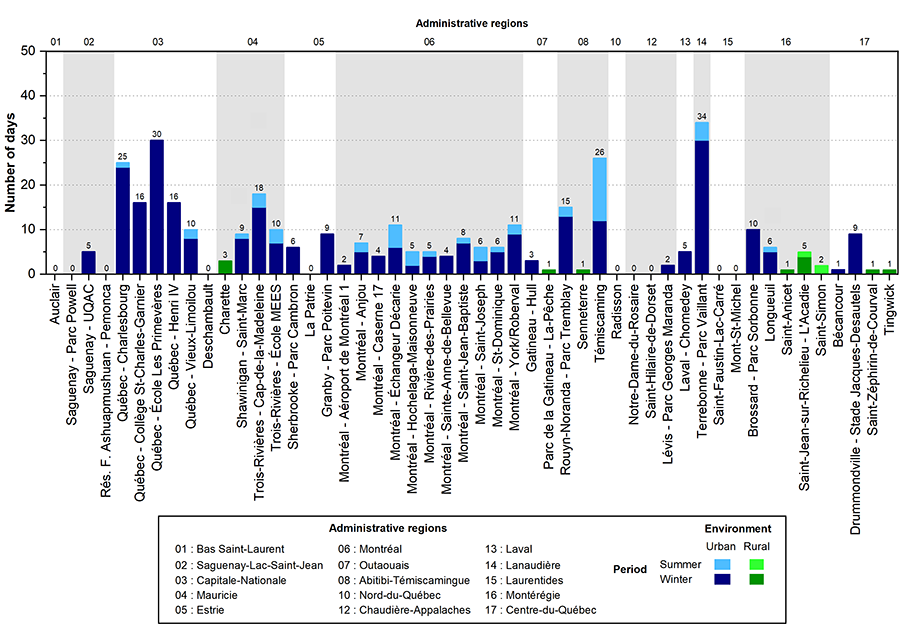
Annual poor air quality statistics
Poor air quality days
A poor air quality day occurs when air quality is rated as “Poor” for at least one hour at one of the stations in the network (French) that monitors fine particulate matter and ozone. The hourly index is considered “Poor” when the average concentration of fine particulate matter is greater than 35 micrograms per cubic metre (µg/m3) over a three-hour period or when the average concentration of ozone is greater than 82 parts per billion (ppb) over a one-hour period. This indicator is calculated per station and takes into account both intense smog days at the regional level and days when poor air quality is observed locally for a short period.
Average annual number of poor air quality days in Québec* (2004–2023)
*Based on daily occurrence of at least one hourly concentration of ozone or fine particulates (averaged over three hours) that respectively exceed 82 ppb and 35 µg/m3 at at least one station in the network in each station.
The average number of poor air quality days per station rose to 17.8 in 2023. This higher figure compared to 2022 is mainly due to the increase in the number of poor air quality days caused by the forest fires (French). Due to these fires, 76% of the poor air quality days per station were recorded during the summer (May to October). In 2022, only 15% of the poor air quality days per station occurred during the summer.
Weather conditions have an impact on the dispersion of contaminants and are the main factor explaining the variation in the number of poor air quality days from one year to the next. Nonetheless, the downward trend observed since 2004 suggests that anthropogenic factors (legislation, more efficient antipollution systems, the closure of polluting industries, etc.) also play a role.
Fine particulate matter is the main cause of poor air quality days. Ozone did not cause any such days in 2023, which is consistent with observations made in recent years (French).
Number of poor quality air days in 2023 per station*, grouped by administrative region

*Based on at least one daily occurrence of an hourly concentration of ozone or fine particulates (averaged over three hours) that respectively exceed 82 ppb and 35 µg/m3.
The forest fires in summer 2023 (French) had a major impact on the number of poor air quality days per station. They resulted in at least three days of poor air quality at each station during the summer period. At the majority of stations, the number of poor air quality days was higher in summer than in winter. The regions most affected by the smoke plumes from these fires were Saguenay−Lac-Saint-Jean, Outaouais, Abitibi-Témiscamingue and Nord-du-Québec. Several rural stations, which normally see few days of poor air quality, were heavily affected by the smoke plumes, particularly the Radisson and Senneterre stations.
Poor air quality days were also recorded in winter in 2023. They occurred in urban areas, where there is a greater density of sources of pollution (transportation, wood heating and industry). Residential wood heating is the main culprit behind these poor air quality days, as confirmed by the Québec – École Les Primevères, Terrebonne – Parc Vaillant and Granby – Parc Poitevin stations.
Other stations, such as the Témiscaming and Saguenay – Powell Park stations, stand out for very specific reasons. The figures from these stations are impacted by emissions from nearby industries, which explains their high number of poor air quality days.
